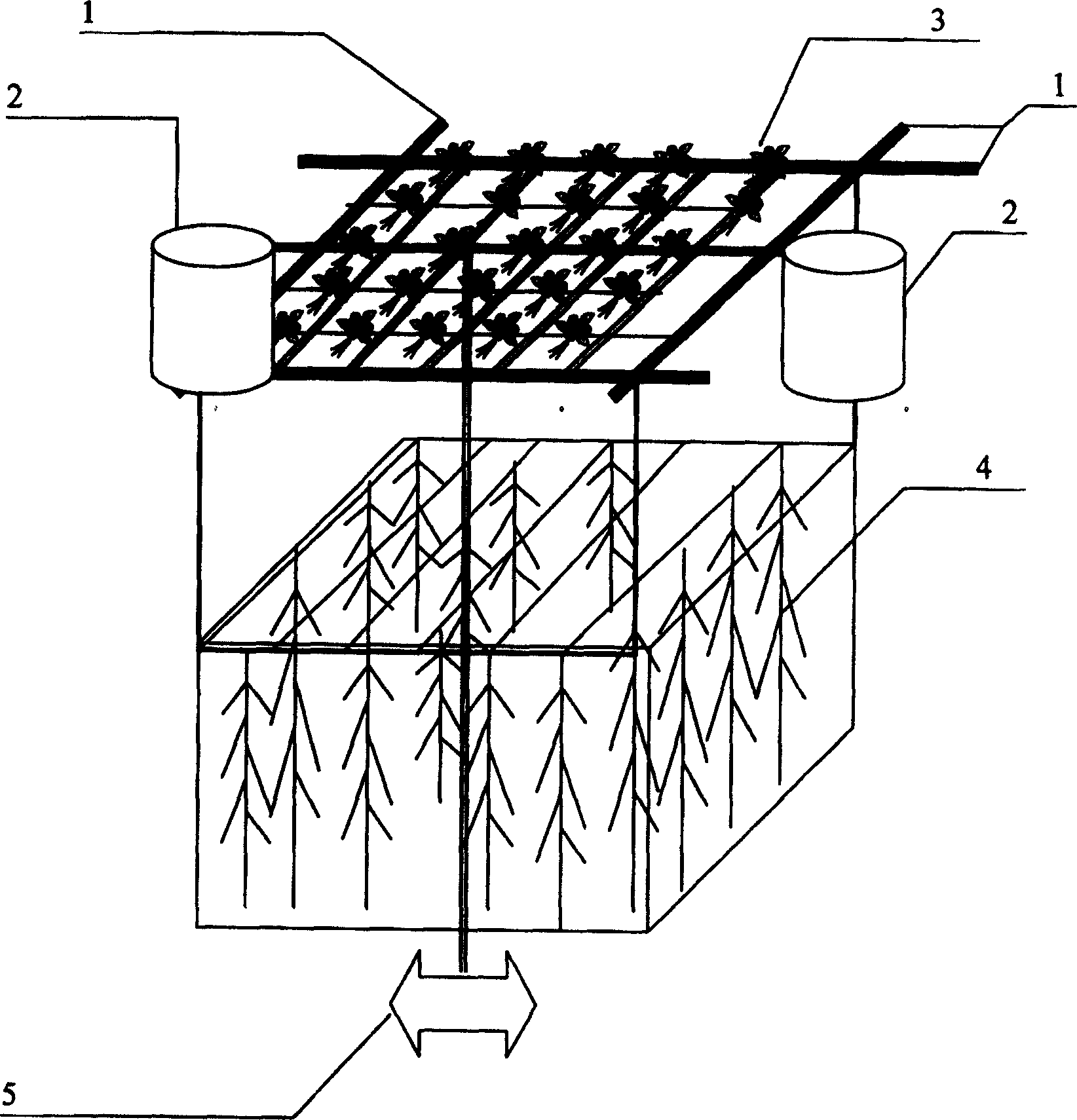Composite stereo biological hover bed
A biological floating bed, three-dimensional technology, applied in the field of biological floating bed, can solve problems such as secondary pollution of water bodies
- Summary
- Abstract
- Description
- Claims
- Application Information
AI Technical Summary
Problems solved by technology
Method used
Image
Examples
Embodiment 1
[0015] Embodiment 1: select bamboos 1 longer than 2 meters to be connected into a quadrilateral, as a floating bed for planting on water, fixed with bamboos around, each size 2m × 2m, by 2 to 4 such bamboo beds to form a grid-like three-dimensional frame , and set two floating buckets 2 on both sides. Float the floating bed in the center of the water. Plant canna 3 and fix it on the uppermost floating bed, with 5×5 plants; the spacing is usually about 50cm and use thin bamboo in the middle to fix the plants on it, and keep the spacing between the plants. The lower hanging elastic material 4 is about 1m long; the bottom is fixed with stones 5 to prevent the floating bed from drifting. The floating bed is placed in the center of the pond or reservoir area, and is applied to a water depth of more than 2.5m: the dead branches are removed according to the season, and the floating bed is replaced regularly (about 1-2 years).
Embodiment 2
[0016] Example 2: Select 1.6-meter-long bamboos 1 to be connected into a quadrangle, as a floating bed for planting on water, fixed with bamboos around them, each size is 1.5m × 1.5m, and a grid-shaped three-dimensional frame is formed by 2 such bamboo beds , and set two floating buckets 2 on both sides. Float the floating bed in the center of the water. The water spinach 3 plants are fixed on the top floating bed, 6×6; the spacing is usually about 30cm, and the plants are fixed on it with thin bamboos in the middle, and the plants keep the spacing. The lower hanging elastic material polyethylene 4 is about 1m long; the bottom is fixed with iron blocks 5 to prevent the floating bed from drifting. The floating bed is placed in the center of the pond or reservoir area, and is applied to a water depth of 2.5m to 5m; the plants are harvested regularly according to the season, and the floating bed is replaced regularly (about 1-2 years).
Embodiment 3
[0017] Embodiment 3: select 1 meter long bamboo 1 to be connected into a quadrangle, as a floating bed for planting on the water, fixed with bamboo around, each size 1m × 1m, constitute a grid-like three-dimensional frame by 4 such bamboo beds, both sides. Set up two floating buckets 2. Float the floating bed in the center of the water. The cress 3 plants are fixed on the top floating bed, 4×4; the spacing is usually about 20cm, and thin bamboo is used in the middle to fix the plants on it, and the plants keep the spacing. The lower hanging elastic material polypropylene 4 is about 2m long; the bottom is fixed with iron blocks 5 to prevent the floating bed from drifting. The floating bed is placed in the center of the pond or reservoir area, and is applied to a water depth of 2.5m to 5m; the plants are harvested regularly according to the season, and the floating bed is replaced every year.
PUM
 Login to View More
Login to View More Abstract
Description
Claims
Application Information
 Login to View More
Login to View More - R&D
- Intellectual Property
- Life Sciences
- Materials
- Tech Scout
- Unparalleled Data Quality
- Higher Quality Content
- 60% Fewer Hallucinations
Browse by: Latest US Patents, China's latest patents, Technical Efficacy Thesaurus, Application Domain, Technology Topic, Popular Technical Reports.
© 2025 PatSnap. All rights reserved.Legal|Privacy policy|Modern Slavery Act Transparency Statement|Sitemap|About US| Contact US: help@patsnap.com

